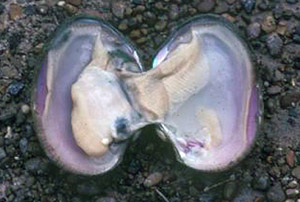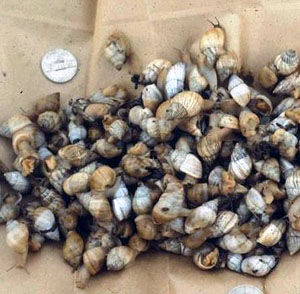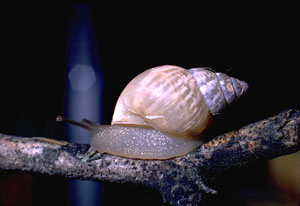Mussels and Snails
Throughout prehistory, both these small, shelled creatures provided not only ready food but material for ornaments for native peoples in south Texas. Mussels (freshwater clams, or unionids) are easily procured from streams and rivers where they lodge in mud banks or gravel beds. Judging from the quantities of shell found in archeological sites in south Texas, they were an important resource. Eaten raw or steamed, mussels provided protein (7-12%) in bite-sized morsels.
The shells were used in a variety of ways, as well. The larger species were used as tools or as containers, such as palettes for paint. The beautiful opalescent interior of the shells inspired many native artisans to transform them into jewelry, such as pendants or disc beads. The shell typically was cut into the desired shape, ground on edges, and drilled to create a hole for a cord. Pendants frequently were decorated with patterns of incised lines.
Archeologists have found shells of these bivalves at sites throughout the South Texas Plains. At the Richard Beene Site on the Medina River just southwest of San Antonio, mussel shell was ubiquitous in almost every component. At Site 41LK201 in Live Oak county, a variety of species were found in both Late Prehistoric and Archaic times. Most common was Lampsilis anodontoides, a species which prefers streams with strong currents.
Land snails, particularly those of the genus Rabdotus, have been found in enormous quantities in archeological sites. Whether these creatures were eaten by native peoples or crawled in to feast on camp garbage has been debated for many years. Increasingly, however, archeologists who carefully study the evidence argue that snails were collected for food.
In south Texas Rabdotus snails occur in colonies that can equal an area equal to about one city block! They were easily collected, particularly during warm months when they are most active. Snails prefer to escape the heat by crawling onto the lower branches of plants or shrubs or under rocks and logs, where they were easy prey for sharp-eyed collectors. The explorer Cabeza de Vaca witnessed the south Texas Mariame Indians collecting and eating snails at the same time that they were harvesting prickly pear tunas in the summer. Since they can sucessfully weather droughts, they may have been a survival food when little else was available.
At the Berger Bluff site on Coleto Creek, diversity ruled the menu, and this held true as well for shelled creatures. At least seven species of mussels and nine of land snails were found in a Late Prehistoric midden (trash dump) dating to roughly A.D. 800-1300. At the Late Prehistoric Hinojosa site, Rabdotus shells were found with pottery sherds, suggesting they were cooked in ceramic pots. Evidence from 41LK201 suggests snails were cooked in hearths. Clearly, there was more than one way to cook a snail dinner.

Freshwater clams, here shown with irridescent shells pried open to expose the “meat,” were valued food resources for native peoples. Photo by Grant D. Hall.
|

This pile of land snails, some no larger than a nickel, is on the move. Steamed, boiled, or baked, the small creatures were a fine source of protein albeit a poor man’s escargot. Photo by Grant Hall. |
